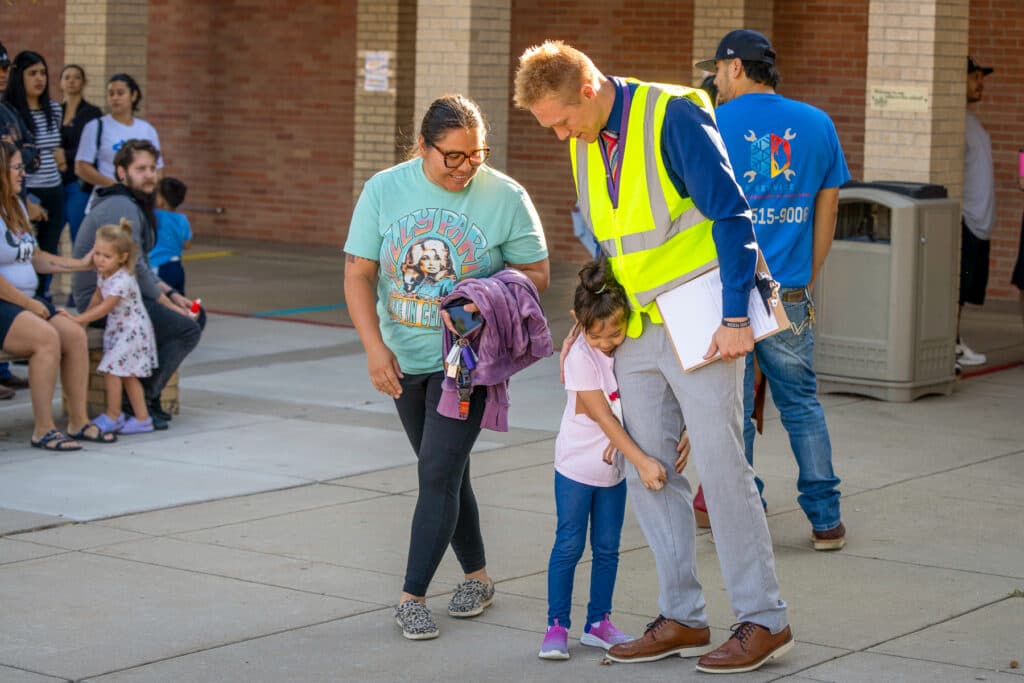
Updated at 12:35 p.m. on Wednesday, August 27, 2025.
More than one out of every four Colorado students is missing a lot of school. The rate of those often-absent students has bumped up slightly last school year from the previous year— about 3,500 more students from the year prior. The bump is a disappointment, after a couple of years of improvement in the state’s chronic absenteeism rate after the pandemic, according to new figures released by the Colorado Department of Education.
The rate of students who are chronically absent, which is missing more than 10 percent of school days or 18 days a year, increased less than a point to 28.4 percent last year. It is still below the post pandemic high of 34.5 percent of students who were chronically absent.
“We wish we had better news to share, but I do think it's really important that we use this as a call to action moment,” said Education Commissioner Susana Córdova. “We did have many districts that improved their attendance, and we know that we have far too many kids who are not attending school on a daily basis, and far too many kids who are chronically absent.”
State officials aren't sure why the numbers haven't improved. Córdova emphasized that it's not due to a lack of effort or focus on the importance of daily attendance. She believes districts are best equipped to explain the trends.
Students leaving state without notifying school and lack of staff are reasons for jump in one district
Englewood Schools saw a five-point increase in the number of students who are chronically absent.
The district found two main reasons for the jump in numbers. First, they discovered their old system kept students on the books long after they had stopped attending. This meant students who had moved away were still being counted as absent, artificially inflating the chronic absenteeism rate. The district has since updated its processes to properly remove these students.
"Tightening up our processes for disenrolling students due to lack of contact and attendance was imperative to ensure our data accurately reflects what is happening," said Superintendent Joanna Polzin.
A second major challenge is a lack of staff dedicated to tracking down students who aren't coming to school. Schools do more than call home when a student is not showing up. They call emergency contacts. They try to track down where a student is living, visit apartment complexes, only to discover students have moved out of state.
In 2023, budget cuts forced the district to eliminate the position responsible for that work. Now, principals are being asked to take on the role of making home visits and checking on students, said Polzin.
"If principals and administrators are conducting home visits...they are not in their buildings, being the instructional leaders that I have empowered them to be," she said.

She said other factors contributing to elementary school absences include student sickness and the possibility that early start times at some elementary schools might be a barrier for attendance.
The state also measures the average daily attendance, which is the total number of days attended by a student divided by the total possible days. That declined slightly from 91.5 to 91.4 percent.
Attendance is critically important. Eighty-three percent of chronically absent students in the U.S. can’t read on grade level by 3rd grade. In the middle grades, they’re more likely to drop out of high school. Showing up more in 9th grade increases the chances of graduating on time.
Colorado has made attendance a priority
Colorado has struggled to return to pre-pandemic rates of attending school, which bounced between 18 percent to 26 percent. In the 2023-24 school year, Colorado had the fifth-highest rate in the nation of students missing lots of school.
The slight worsening in the last school year doesn’t bode well for one of the department’s key strategic goals: cutting chronic absenteeism to 15 percent by the 2027-28 school year. The state launched a campaign called “Every School Day Matters” that includes increased training and resources for educators and school leaders.
Schools, teachers and state officials put extra effort into strategies to boost attendance. The state brought cohorts of districts together to learn from each other and share best practices, expanded tools and guidance to schools (two-thirds of those saw improvements), and targeted state and federal grants to some districts to boost attendance. What Colorado is doing to reduce chronic absenteeism is featured on the front page of one of the main national organizations on the issue, Attendance Works. More than 50 districts opted into a ‘50%’ challenge to cut chronic absenteeism rates in half.
Last school year, the grades with the highest absenteeism were eighth, ninth, 10th, 11th and 12th, with more than 30 percent of students chronically absent. The best attended grade at 21.9 percent: third grade.
A bright spot is that kindergarten and first grade saw improvements in chronic absenteeism. Right after the pandemic, kindergarteners had the highest chronically absent rate after 11th and 12th graders.
Efforts to boost school attendance differ depending on the student's age. For elementary students, the goal is to help parents see how important school is and to remove obstacles like a lack of transportation. For older students, the approach changes because they have more say in their own lives. The focus shifts to building relationships to understand why they're not coming to school.
A successful strategy may include helping kids practice setting alarms
York International, a K-12 school in the Mapleton district has successfully reduced chronic absenteeism. Assistant principal Ben Schneider said tackling attendance takes an “immense amount of time” and precious school resources — but it pays off.
The school holds weekly meetings to create quick plans for students who are struggling with attendance. Middle and high school students are invited to a lunch meeting to complete a survey that helps identify the root cause of their absences. The school then offers targeted support or small group sessions.
Schneider shared an example where a group of students admitted they simply couldn't wake up in time for the first period.
“We sat together and set alarms on our phones together to wake up in the morning and I followed up with messages home to parents letting them know that that's what we had done and asking them to support their student in waking up on time and getting to school for a breakfast.”
Sometimes the reasons for absence are more complex, such as transportation issues, social-emotional problems, or mental health issues. Other times, students feel lost in class and find it easier to just not show up.
"Teachers love jumping in and helping with that once they realize that that's why a student isn't coming to class," Schneider added.
A community-focused approach
Lincoln Elementary in Loveland has also seen a significant improvement, with a 5.7-point drop in chronic absenteeism over the last two years. Every day, multiple staff members greet students as they arrive. The school hired a family engagement specialist to help families with things like transportation, food, and jobs.
That didn't fix everything. The school also has a specialized attendance team that directly contacts families to offer personalized support.
“We really focus on support, not punishment,” said principal Brandi Stott. “That I think has been one of the biggest levers in terms of improving our attendance.”
Some students struggle with chronic absenteeism more
The student group with the highest chronic absenteeism rate were homeless students, with 57 percent missing 18 or more days a year. That is followed by students who qualify for free and reduced-price lunch (40 percent), migrant students (40 percent), multilingual learners (38 percent), and special education students (36percent). All groups saw increases except for migrant students, who are students whose parents work in migratory agricultural work.
Rates of chronic absenteeism in all racial and ethnic groups went up except Asian students. The rates with the highest rates of chronic absenteeism were also the smallest groups: American Indian/Alaska Native (5,203 total students with 45 percent chronically absent) and Hawaiian or Other Pacific Islander (3,208 total students – 51 percent). Black (34 percent) and Hispanic (38 percent) students were above the state average. Hispanic students saw the largest increase with 4,569 additional chronically absent students, or about 1.3 percentage points.
Some districts improve, others don’t with poverty a factor
Children living in poverty are two to three times more likely to be chronically absent. Poverty can create barriers from housing instability, lack of reliable transportation or food insecurity. Families may be juggling multiple jobs or older siblings care for young children not yet in school. Absences may also be tied to health problems such as untreated asthma or diabetes, oral health challenges or mental health issues.
Half the students in the tiny Centennial R-1 district (160 students) in San Luis were chronically absent with more than 90 percent living in poverty.
The Adams 14 district in Commerce City has one of the highest chronic absenteeism rates in the state at 43.9 percent. Almost 90 percent of the nearly 5,000 students live in poverty with 55 percent of students learning English as a second language. But the chronic absenteeism rate dropped 5 points from last year.
The Agate school district in the Eastern Plains improved its chronic absenteeism rate from 24.7 to 9.2 percent. But there are only about 70 students in the whole school district. Aspen’s chronic absenteeism rate dropped 6.7 points.
In larger urban school districts, among those that saw chronic absenteeism rates drop were Pueblo (-1.4), Aurora (-1.2) , Boulder (-.3), Littleton (-.2), Cherry Creek (-.2), and Poudre (-3.5). Among large school districts that saw chronic absenteeism rates go up were Jefferson County (+.9), Denver (+1.0), St. Vrain Valley (+1.3), Mesa County 51 (+1.5), Westminster (+2.9), Englewood (+4.5), and Colorado Springs 11 (+16.6).
What’s next?
State officials say they’ll expand the support they offer schools this year. Research shows home visits are very effective, as well as these evidence-based strategies:
- Engaging families about attendance through text messages and postcards can nurture awareness. It also provides motivation for parents to get their kids in school
- Telling parents their child is missing but also comparing them to their peers can be helpful.
- Using warm and inclusive language that stresses shared purpose more effective than legalistic or threatening language
Other research shows investments in safe and more accessible transportation can lead to significant improvements in student attendance. Programs that target physical and mental health needs are also effective. Research shows students are more likely to attend school when their school work connects to their own identity and when they feel a sense of belonging at school.
Editor's note: This story has been updated with more information from the state education commissioner and from school districts successfully addressing chronic absenteeism.









